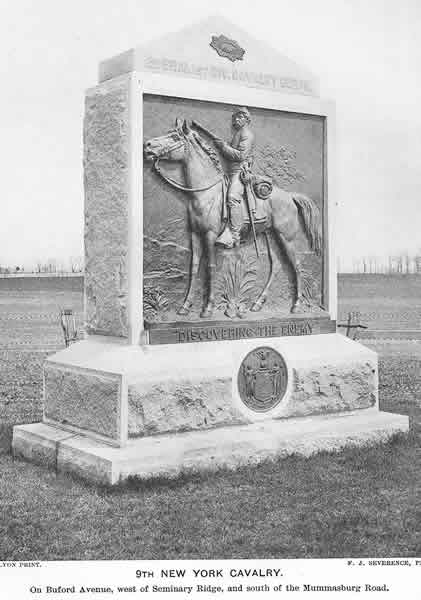History of the 9th New York
The 9th New York Volunteer Cavalry, Company F was organized in Westfield NY, between September 9th and November 19th, 1861. Along with 9 other companies: A, B, C, E, G, H, I, K, M, this made up the 9th NY Volunteer Cavalry. First under the command of Colonel, John Beardsley, the 9th was split up on March 9, 1862. Companies C, F, K, and M, were distributed among the Reserve Artillery until late June, 1862. The remaining companies were assigned as train guards for the Army of the Potomac until Mid-September, 1862 when the companies were re-united. In March 1863, Colonel John Beardsley was forced out of service and resigned his post to William Sackett who led the 9th NY through the Battle of Gettysburg and until he was mortally wounded on June 11, 1864 at the Battle of Trevilian Station in VA. He succumbed to his injuries three days later.

Cpl. Alpheus Hodges and the Battle of Gettysburg
In charge of an advanced picket post the
morning of July 1, 1863 along Willoughby Run, with three other privates from Company F,
Hodges had stopped to water his horse and was suddenly fired upon by a line of advancing Confederates. He immediately sent back the 3 to alert Colonel Sackett. Hodges fell back to a higher point to observe the advancing enemy. He then returned to the bridge crossing Willoughby Run and succeeded in returning fire. Records say that Cpl. Hodges fired multiple shots and therefore opened the Battle of Gettysburg.
Records say that this occurred at about 5:20 A.M. This exchange of shots is believed to be the first shots fired at the battle of Gettysburg on the morning of July 1, 1863. When Hodges rode back from the bridge to the higher ground east of Willoughby Run he found Col. Sackett had formed a skirmish line of his entire picket force. A detachment of the 8th Illinois Cavalry later rode out the Chambersburg road and had a skirmish about half a mile beyond Willoughby Run.
There are many others who attempt to claim the right of firing the opening shot. But the earliest reports claim that they fired at around 8:30 A.M. No other reports claim a firing time earlier than Cpl. Hodges time of 5:20 A.M.
The monument at Gettysburg states "Discovering the Enemy" and depicts Cpl. Alpheus Hodges spotting the enemy lines. This was sculpted Casper Burble of New York. The monument sits on Buford Avenue on the regiments main battle line and cost about $2500 in when it was dedicated on July 1st, 1888. The back states "Position, 8 am, July 1st 1863, Picket on Chambersburg Road fired on at 5 am."
Contact Us: Email